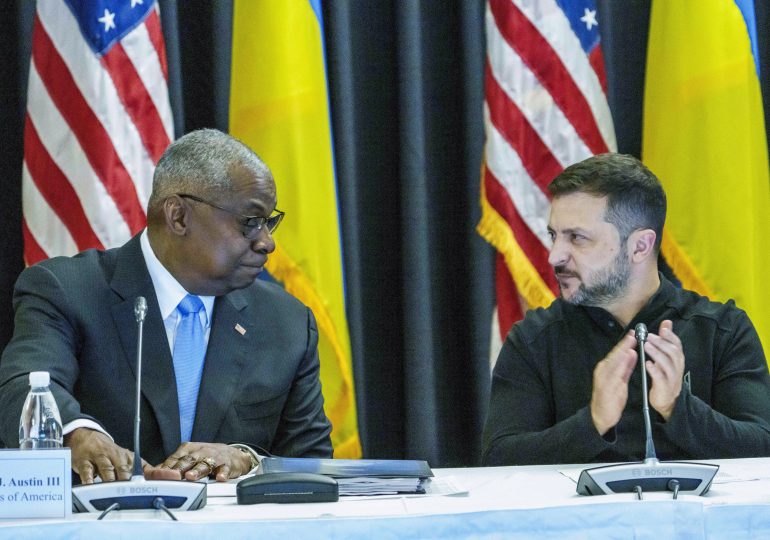RAMSTEIN AIR BASE, Germany — Ukraine needs the ability to strike deep within Russia now, President Volodymyr Zelenskyy urged top U.S. and allied military leaders Friday in Germany, as Kyiv continues to press its case that without long-range strikes and bolstered air defenses, it faces a bleak winter.
The meeting of the Ukraine Defense Contact Group was taking place during a dynamic moment in Ukraine’s fight against Russia, as it conducts its first offensive operations of the war while facing a significant threat from Russian forces near a key hub in the Donbas. It also comes days after Russia launched a deadly airstrike against a Ukrainian military training center that killed more than 50 and wounded hundreds.
[time-brightcove not-tgx=”true”]
Then on Friday Russia fired five ballistic missiles at the city of Pavlohrad in the eastern Dnipropetrovsk region, injuring at least 50 people, regional Gov. Serhii Lysak said. Three of those injured in the daylight attack were children aged four, nine, and 11 years old, he said.
“We need to have this long-range capability, not only on the divided territory of Ukraine, but also on the Russian territory, so that Russia is motivated to seek peace,” Zelenskyy told the contact group. “We need to make Russian cities and even Russian soldiers think about what they need: peace or Putin.”
To date, the U.S. has been reluctant to further loosen restrictions on the long-range missiles it does provide, out of concerns that it could further escalate the conflict.
However, Canadian Defense Minister Bill Blair said Zelenskyy convinced him to support the long-range strike use and that he hopes the other Western allies also get behind the ask. Canada does not have long-range munitions it could provide on its own, Blair said.
“One of the things President Zelenskyy and his ministers have made very clear to us is that they are suffering significant attacks from air bases and military installations located within Russia,” Blair said. “We support their request for permission, but it’s still a decision of our allies.”
So far, the surprise assault inside Russia’s Kursk territory — in which Zelenskyy said Ukraine has been able to capture about 1,300 kilometers (800 miles) of Russian territory and kill or injure about 6,000 Russian soldiers — has not drawn away President Vladimir Putin’s focus from taking the Ukrainian city of Pokrovsk, which provides critical rail and supply links for the Ukrainian army. Losing Pokrovsk could put additional Ukrainian cities at risk.
While Kursk has put Russia on the defensive, “we know Putin’s malice runs deep,” and Moscow is pressing on, especially around Pokrovsk, U.S. Defense Secretary Lloyd Austin said.
Recent deadly airstrikes by Russia have renewed Zelenskyy’s calls for the U.S. to further loosen restrictions and obtain even greater Western capabilities to strike deeper inside Russia. Zelenskyy also said systems that were already promised have been too slow to arrive.
“The number of air defense systems that have not yet been delivered is significant,” Zelenskyy said.
German Defense Minister Boris Pistorius said the systems promised, particularly Patriot air defense systems, need to be delivered to help Ukraine defend its electrical grid and infrastructure during winter fighting. Last year Russia repeatedly struck power systems in Ukraine.
During the meeting Austin announced the Biden administration would provide another $250 million in weapons to Ukraine, including air defense munitions and artillery.
As well as resources for air defense and artillery, the meeting Friday was expected to focus on shoring up gains in expanding Ukraine’s own defense industrial base, to put it on more solid footing as the final days of Joe Biden’s U.S. presidency wind down.
Western partner nations were working with Ukraine to source a substitute missile for its Soviet-era S-300 air defense systems, Austin said.
The U.S. is also focused on resourcing a variety of air-to-ground missiles that the newly delivered F-16 fighter jets can carry, including the Joint Air-to-Surface Standoff Missile, which could give Ukraine a longer-range cruise missile option, said Bill LaPlante, the Pentagon’s top weapons buyer, who spoke to reporters traveling with Austin.
No decisions on the munition have been made, LaPlante said, noting that policymakers would still have to decide whether to give Ukraine the longer-range capability.
“I would just put JASSM in that category, it’s something that is always being looked at,” LaPlante said. “Anything that’s an air-to-ground weapon is always being looked at.”
For the past two years, members of the Ukraine Defense Contact Group have met to resource Ukraine’s mammoth artillery and air defense needs, ranging from hundreds of millions of rounds of small arms ammunition to some of the West’s most sophisticated air defense systems, and now fighter jets. The ask this month was more of the same — but different in that it was in person by Zelenskyy and followed a similar in-person visit Thursday in Kyiv by Biden’s Deputy National Security Advisor Jon Finer as Kyiv shores up U.S. support before the administration changes.
Since 2022, the member nations together have provided about $106 billion in security assistance to Ukraine. The U.S. has provided more than $56 billion of that total.
The German government said Chancellor Olaf Scholz plans to meet Zelenskyy in Frankfurt on Friday afternoon.
Leave a comment








